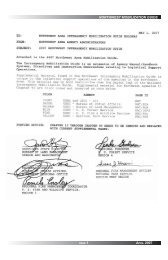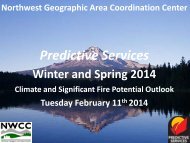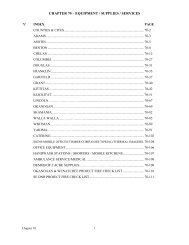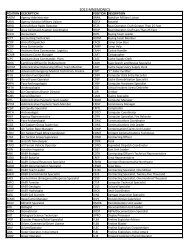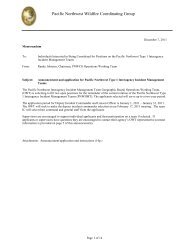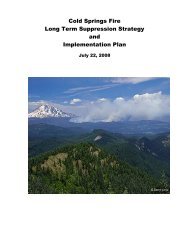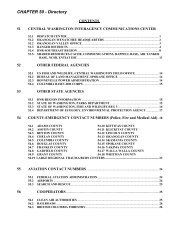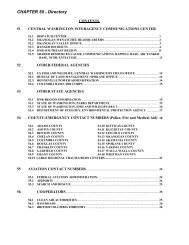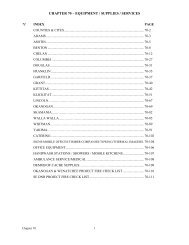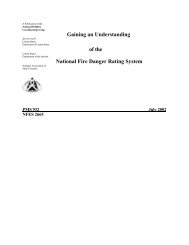Charts for interpreting wildland fire behavior characteristics - NWCC
Charts for interpreting wildland fire behavior characteristics - NWCC
Charts for interpreting wildland fire behavior characteristics - NWCC
You also want an ePaper? Increase the reach of your titles
YUMPU automatically turns print PDFs into web optimized ePapers that Google loves.
FORMS OF THE CHART<br />
The <strong>fire</strong> <strong>behavior</strong> chart and the NFDRS chart illus-<br />
trated in figures 1 and 2 have scales that do not cover<br />
the entire range of possible values. The scales were<br />
chosen to give resolution to the lower values and allow<br />
the majority of values to be plotted on the chart. Never-<br />
theless, some points will fall beyond the limits of the<br />
graph. A <strong>for</strong>m of the <strong>fire</strong> <strong>behavior</strong> chart that overcomes<br />
this limitation uses logarithmic scales on the axes. In<br />
this way the entire range of values can be covered. The<br />
curved flame length lines become straight lines on the<br />
log scale version of the chart.<br />
Figure 14 shows six points plotted on both linear and<br />
logarithmic scale <strong>fire</strong> <strong>behavior</strong> charts. This illustrates<br />
that a relatively small change in the <strong>behavior</strong> of a low-<br />
intensity <strong>fire</strong> is amplified, and a large change in the<br />
<strong>behavior</strong> of a high-intensity <strong>fire</strong> is compressed on the<br />
logarithmic chart. Because a primary purpose of the <strong>fire</strong><br />
<strong>characteristics</strong> chart is to visually illustrate changes in<br />
<strong>fire</strong> <strong>behavior</strong>, care should be taken in interpretation of<br />
relative location or points plotted on the logarithmic<br />
chart.<br />
Figure 14.-The same six points (A, B, C. X, Y. Z) plotted <strong>for</strong> comparison on both a linear<br />
scale (A) and a logarithmic scale (B) <strong>fire</strong> <strong>behavior</strong> chart.<br />
11 may be necessary to change the scales of a chart<br />
primarily used <strong>for</strong> a specific fuel type. For example, a<br />
chart primarily used to display <strong>fire</strong> <strong>behavior</strong> predictions<br />
in logging slasli should have an expanded heat-per-unit-<br />
area axis and a truncated rate-of-spread axis. Such a<br />
chart is shown in appendix B, along with other full-size<br />
charts suitable <strong>for</strong> reproduction. Appendix A offers the<br />
equations used in creating the <strong>fire</strong> <strong>characteristics</strong><br />
charts.<br />
An NFDRS chart can illustrate NFDR manning<br />
classes <strong>for</strong> a specific area. USDA Forest Service <strong>fire</strong><br />
specialists generally determine manning classes from<br />
the 90th and 97th percentile burning index values <strong>for</strong> a<br />
specific station and fuel model. The percentile values<br />
are determined from historical <strong>fire</strong> weather obser-<br />
vations and provide criteria <strong>for</strong> ranking the relative<br />
severity of the burning conditions on a given day.<br />
Appendix A includes an example showing how to<br />
design an NFDRS chart where BI lines designate<br />
manning class levels.<br />
FIRE BEHAVIOR<br />
Fire Ctiaracteristics Chart<br />
(Lcqarithmic Scale)<br />
HEAT PER UNIT AREA, BTUl FTZ 148




